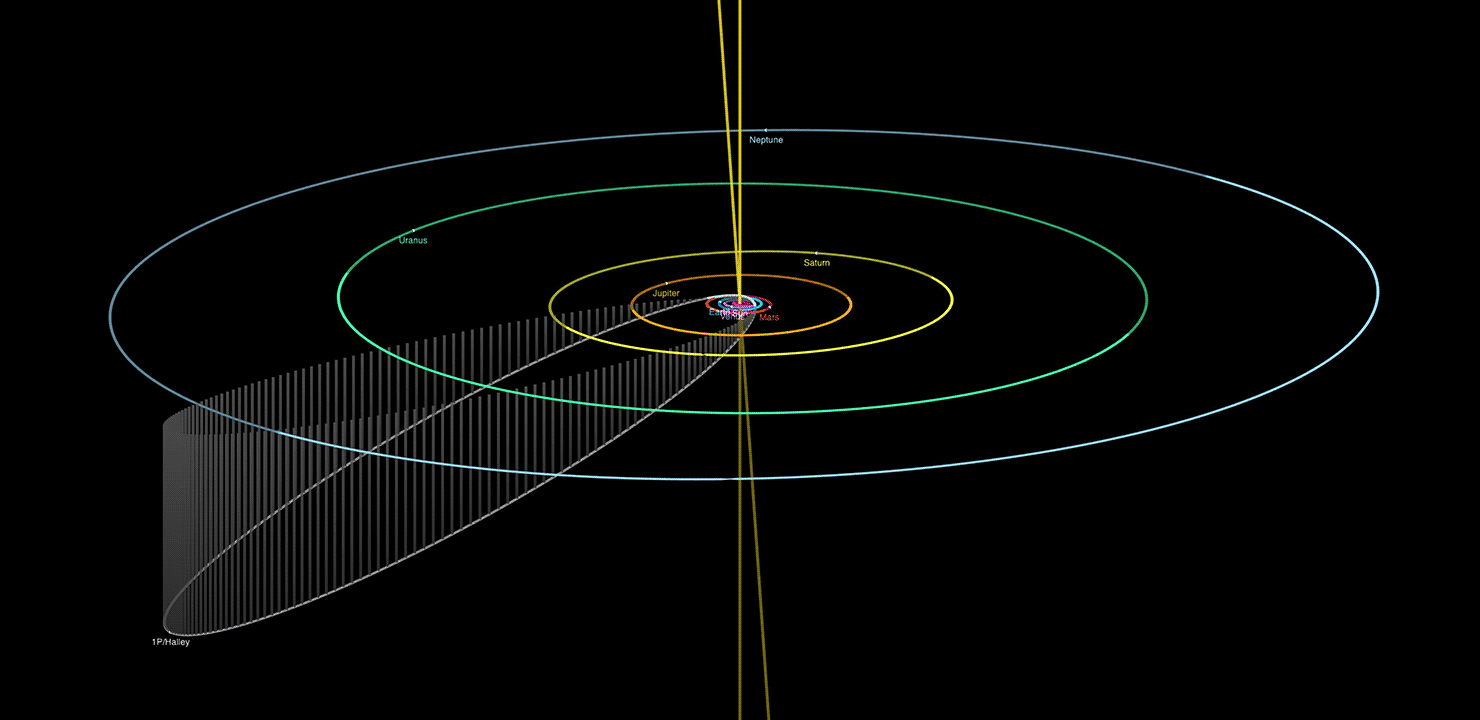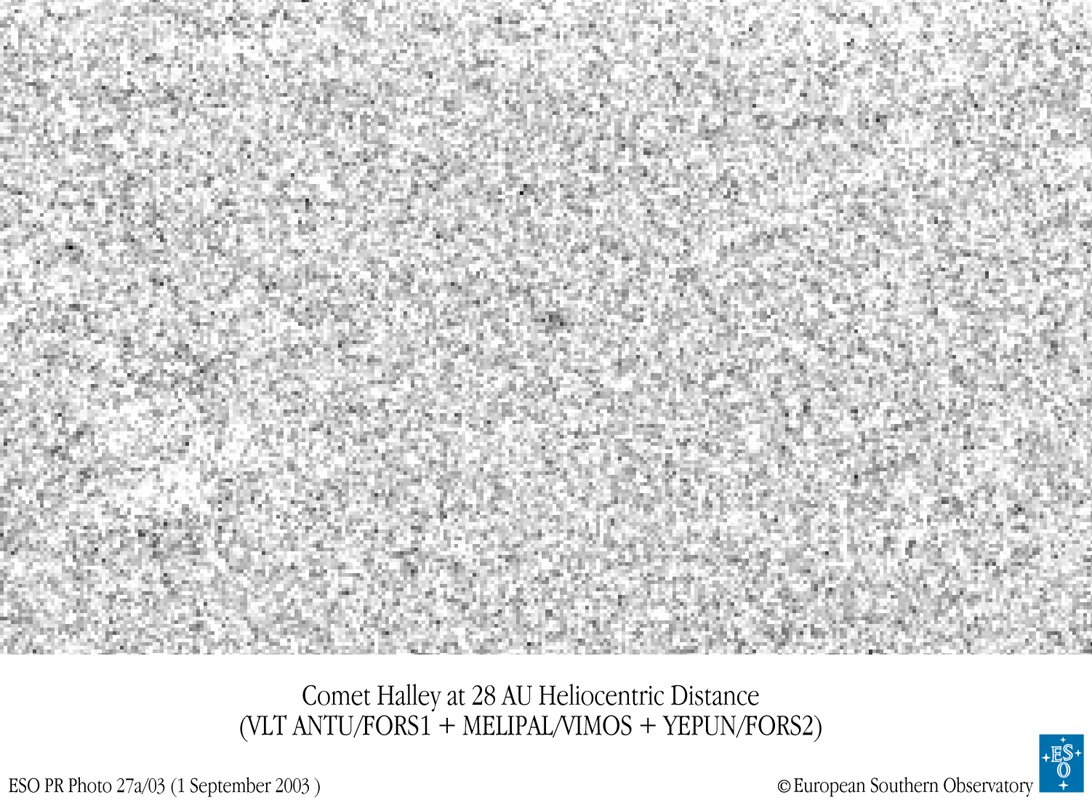
Halley's Comet at Aphelion
December 2023 :
When we talk about comets, we often think about relatively dim, fuzzy visitors from the outer solar system that, if we’re lucky, appear high enough in a darkened sky to show in our telescopes, or maybe even binoculars.
Any specific comets whose names are remembered long after their appearances are the ones that blaze in the sky, bright enough to see without optical aid, and leave lasting impressions, even decades after they fade into obscurity. Names like Hale-Bopp and Hyakutake instantly come to mind. Sure, there have been bigger and brighter comets, but for Earth’s northern hemisphere, there are few that get the recognition of local skywatchers.
Other recent comets that may be remembered, may not have appeared very bright, or remained in our sky for long, include names like NEOWISE, PanSTARRS, and 17P/Holmes.
With the exception of Holmes, which underwent an outburst several months post-perihelion, we usually watch the comets that are nearest to the point of their orbits closest to the Sun–perihelion–and pay little attention to them when they fade from view as they move farther away, toward their farthest point from the Sun, aphelion.
The most familiar comet in history, 1P/Halley, is no exception. The excitement around Halley was sky-high in the mid-1980s, when it made its last appearance in the inner solar system.Sales of telescopes spiked dramatically, an international armada of five space probes were sent to study the comet, and a dedicated “Halley Night” at Seagrave Observatory attracted over 2,000 visitors.
But it has been many years since Halley’s Comet has been talked about, but there is a milestone occurring in late 2023 that is worthy of mention.
Halley’s Comet reaches aphelion, the farthest point in its orbit around the Sun, at about 8:00pm EST on December 8, 2023. Beyond the orbit of Neptune, this point is 35.143 AU from the Sun. It is notable that this is even more distant than Pluto, when it was still classified as a major planet at the time, during the comet’s 1986 perihelion.
At the slowest point in its orbit, the comet is moving at 0.910 km/s relative to the Sun, which has been the acknowledged top speed of the Lockheed SR-71 Blackbird. This occurs on March 19, 2024, notably about three months past perihelion, since the comet orbits the solar system’s barycenter rather than the Sun itself.
A Look Back: Halley’s Last Aphelion
Perhaps the most intriguing property of Comet Helley, besides being the first known periodic comet, is that its orbital period spans an average human lifetime. Because of this, it is an interesting exercise to use the comet’s period as a measure of history.
Looking back to Comet Halley’s last aphelion, we find ourselves in a different era, one before large survey telescopes, digital imaging, and interplanetary space probes significantly advanced our knowledge of the universe. The date was February 22, 1948.
Our solar system seemed a bit more sparse than it does today. While we knew of nine planets, the number of known moons for all the planets totaled 29, just one-tenth of the number of known moons today. Notably, Jupiter had only eleven moons, and Saturn had just nine. Uranus’ fifth moon, Miranda, was discovered just six days before by Gerard Kuiper, and Neptune’s second, Nereid, was not known until the following year. Pluto’s largest moon, Charon, would not be found for another three decades.
In early 1948, the number of known asteroids stood at just 1,600, and only a few dozen comets had been cataloged. Today, we know of over 1.3 million asteroids (more collectively known as minor planets), and nearly 4,000 comets.
In February 1948, science and aerospace technology was just beginning to take off at a rapid pace. The first supersonic airplane flight, piloted by Chuck Yeager, had taken place 4 months prior, and although this preceded the period of orbital spaceflight by nearly a decade, test flights of captured German V-2 rockets were routinely reaching the Karman line, many of them carrying atmospheric and heliophysics instruments on board.
The largest optical telescope in the world, the 200-inch Hale Telescope on Palomar Mountain in California, would be dedicated a few months after Comet Halley’s 1948 aphelion. Palomar Observatory would become significant in Halley history, as it was the first telescope to recover the comet on its inbound approach to its 1986 perihelion, on October 16, 1982, when the comet was still 11.04 AU from the Sun.
In early 1948, Skyscrapers had been in existence for just over 15 years, and had been running Seagrave Memorial Observatory for just over 11 years. The Alvan Clark telescope was 70 years old, and occupied the only building on the observatory grounds, as the Crawford dome (whose concrete pad is the only remaining element today) would be completed later that year, and the meeting hall would not be built for another four years.
A Look Ahead to the Return of Comet Halley
As we move past aphelion, we can look forward to Halley’s next perihelion, in 2061, which will now be closer in time to us than its previous one in 1986. The comet will be closest to the Sun on July 28 of that year, and closest to Earth the following day.
Prospects for observing the comet in the northeastern United States are fairly good, considerably more so than its previous apparition in 1985-1986, when it reached perihelion while on the opposite side of the Sun from Earth, and its closest pass to Earth had it very low on the southern horizon two months later.
While its 2061 closest passage to Earth is about 15% more distant as it was in 1986, it nearly coincides with perihelion, and is in a better position in the sky for the mid-northern latitudes. Halley will be in the northern constellation Lynx, only a few degrees south of circumpolar for us in Rhode Island, so it will be visible in both the morning and evening skies.
Halley’s Comet has been known to exhibit both an ion tail, and a substantial dust tail during its many previous visits to the inner solar system, so we expect its next appearance will be no different. Since the comet will be between Earth and the Sun, but about 20 degrees north of the ecliptic, we’ll be looking into the tail, and the extended tails would be closer to us than the coma. They will likely spread a good distance into the northern sky and be visible despite the light of a waxing gibbous Moon.
But before we get there, here are some milestones to note along the way.
|
Milestone |
Date |
Distance (Sun) |
Velocity (Sun) |
|---|---|---|---|
|
Orbit of Neptune |
July 5, 2041 |
30.0699 AU |
3.072 km/s |
|
Orbit of Uranus |
May 12, 2053 |
19.1891 AU |
6.555 km/s |
|
Orbit of Saturn |
December 3, 2058 |
9.5366 AU |
11.669 km/s |
|
Orbit of Jupiter |
June 26, 2060 |
5.2028 AU |
17.063 km/s |
|
Velocity of Voyager 1 |
August 18, 2060 |
4.7081 AU |
16.774 km/s |
|
Orbit of Mars |
May 16, 2061 |
1.5237 AU |
33.307 km/s |
|
Orbit of Earth |
June 19, 2061 |
1.0000 AU |
52.608 km/s |
|
Perihelion |
July 28, 2061 |
0.5928 AU |
54.250 km/s |
|
Closest to Earth |
July 29, 2061 |
0.4774 AU* |
* Distance from Earth
A Look Beyond: Aphelion 2097
A complete orbit of Halley from now, it will be near its next aphelion, on November 21, 2097.
What will be the state of backyard astronomy in 2097? Will we be able to detect Halley’s faint, dormant nucleus at the icy fringe of the solar system, using readily available equipment? What “Great” comets will we have seen since Halley made its last appearance in 2061?
Will Voyager 1, likely decades beyond its last contact with Earth, still be the farthest human-made object (424 AU) from home?
By the time we come upon the next aphelion of Comet Halley, Rhode Island will have experienced its first total solar eclipse (May 1, 2079) since 1925, and the next transit of Venus (December 21, 2117) will be just 20 years away.
Back to the present: If you want to start looking for Halley’s Comet in late 2023, turn your telescope to RA 08h 22m 16.85s, Declination +02° 11m 42.7s, a point in northwestern Hydra, about 4° west of Minchir (σ Hydrae). From there, the comet slowly migrates about 1/4° west-northwestward each year, upon cycling through its retrograde loop.
Although it likely will not be visible through our backyard telescopes, or picked up on our most sensitive imaging cameras for a few more years, it is worth noting that in December 2003, at a distance of 28.06 AU, Halley’s Comet was detected by European Southern Observatory’s Very Large Telescope (VLT) at Paranal, Chile. This is the farthest that any comet has ever been seen. Even though the comet is now 25% more distant today than it was 20 years ago, it will still be within reach of the instrument that captured it in 2003. Halley’s Comet will never again be beyond our gaze.




